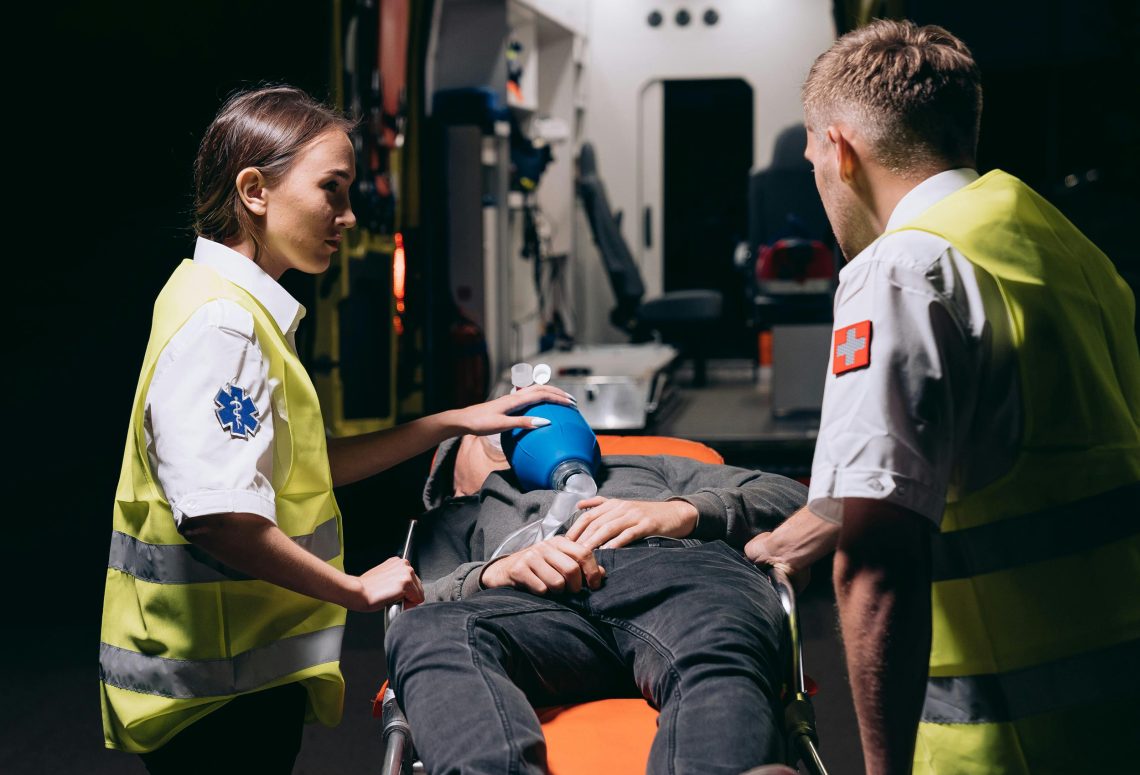Gain crucial knowledge on fundamental first aid techniques to effectively render assistance during accidents or emergencies. Your prompt intervention may play a pivotal role in preserving lives.
Every single day, countless individuals experience severe injuries across the globe. Regardless of whether they endure a minor burn or a life-threatening trauma, having a solid foundation in basic first aid is crucial to mitigating the escalation of such incidents. It can frequently serve as the decisive factor between survival and fatality.
85% of adults lack the knowledge and confidence to provide first aid in emergency situations, highlighting the need for increased dissemination of life-saving information. Acquiring a basic understanding of first aid can potentially save lives and ensure the safety of individuals until professional help arrives.
This article aims to provide valuable insights into first aid techniques and address a range of accidents and emergencies that individuals should be ready to face. However, it’s important to note that reading this article alone does not qualify you as an expert in first aid. To become a proficient first aider, it is recommended to undergo official training courses that offer comprehensive instruction. The purpose of this article is to enhance your overall preparedness in handling emergency situations.
Understanding the Basics of Initial Medical Assistance
Prompt and effective action is essential in the field of first aid when faced with a person experiencing an illness or injury. The fundamental objective of emergency first aid is to minimise the deterioration of the individual’s condition, preserve their life, and facilitate their recovery. The care you administer prior to the arrival of professional medical assistance plays a critical role in this process.
Having a solid foundation in first aid training equips individuals with the necessary knowledge and skills to provide emergency care. Whether you find yourself in a professional setting, at home, or out in public, acquiring these fundamental abilities can make a significant difference in assisting others during unforeseen incidents.
Advantages of Acquiring Fundamental First Aid Knowledge:
- Having the capability to offer assistance during unforeseen circumstances.
- Possessing the ability to adhere to the correct protocols
- Having the capability to manage individual health emergencies.
Essential First Aid Measures
To begin your exploration of first aid guidance for different accidents and emergencies, it is essential to grasp the fundamental principles known as the ABCs of first aid.
- When encountering someone who is not breathing, it is crucial to assess their airway first by examining whether it is unobstructed. This can be accomplished by opening the individual’s mouth and visually inspecting it.
- If their airway is unobstructed but they are still unable to breathe, it becomes necessary to administer rescue breaths. In order to ascertain whether they are breathing, you can observe movements of the chest, listen for breath sounds, or feel for the rise and fall of breath.
- During the process of administering rescue breaths, it is essential to simultaneously perform chest compressions to ensure proper circulation of the person’s blood. Detailed instructions on how to perform CPR can be found in our supplementary article.
Essential Knowledge of Handling Accidents and Emergencies
Gaining knowledge about various types of incidents that one may encounter is an essential aspect of basic first aid training. Here, we provide an overview of the most frequently occurring accidents and emergencies, along with practical first aid advice on how to handle each situation.
Anaphylaxis
Anaphylaxis also known as anaphylactic shock, can be triggered by a severe allergic response to an insect bite or consumption of certain foods. The negative response can manifest rapidly, necessitating a prompt and efficient reaction. The individual affected may experience significant difficulty breathing due to swelling of the tongue and throat, which can result in airway obstruction.
Essential Guidelines for Dealing with Anaphylaxis
- It is imperative to promptly contact the appropriate emergency hotline, such as 999 or the designated emergency number in your country.
- Make sure to verify if the person is carrying any medication, as individuals with severe allergies typically carry medication with them at all times. This medication is commonly in the form of a pre-filled syringe.
- Either help the person administer the medication or do it yourself if you know how.
- Once the medication has been given, look after the person until professional help arrives.
Choking
If the individual’s airway is partially blocked due to mild choking, they should be able to resolve it by coughing or spitting. However, If the choking is severe, assistance is required. Failure to intervene could lead to unconsciousness.
Life-Saving Techniques for Handling Choking Emergencies
- In the event that the individual is older than twelve months, proceed with administering back blows.
- To assist someone who is choking, stand behind them and tilt them slightly forward. Place one hand on their chest and grasp it with your other hand. Deliver up to five forceful blows between their shoulder blades using the heel of your hand.
- Continue the process until the obstruction has been resolved.
- If the obstruction does not resolve, proceed by performing five abdominal thrusts, commonly referred to as the Heimlich manoeuvre. To execute this technique, position yourself behind the individual and encircle their waist with your arms. Create a fist with one hand and clasp it firmly with the other. Subsequently, apply forceful and rapid upward pressure to the abdominal region.
- If the individual is still experiencing difficulty breathing, it is advisable to contact emergency services at 999 and request an ambulance.
Burns
In cases of burns and scalds, it is crucial to react promptly and halt the burning process. The extent of the burn depends on its depth and the size of the affected area. This assessment will assist in deciding whether emergency assistance is needed, depending on whether it is a first-degree or third-degree burn. In the event of a severe burn, it is imperative to contact emergency services immediately by dialling 999.
Essential Guidelines for Treating Burns
- To alleviate the pain, it is advisable to cool the burn using cool running water. It is important to remove any clothing or accessories that are in close proximity to the burn.
- After the burn has cooled down, it is important to lightly cover it with cling film, a non-fluffy material, or a bandage to protect the affected area.
- It is advisable to refrain from applying any form of lotion or cream to the burned area.
Heavy bleeding
The primary objective in cases of severe bleeding is to consistently apply pressure to the wound to halt the flow of blood and prevent further loss. Adequate first aid measures are generally effective in managing bleeding.
When attempting to mitigate the risk of infection, it is advisable to use disposable gloves. It is recommended to inspect the wound for any foreign objects. If any are present, avoid applying pressure to the object and instead create a cushioning layer around it.
If there is excessive bleeding and the wound is severe, it is crucial to contact emergency services at 999 without delay.
Essential Guidelines for Dealing with Severe Bleeding
- If there is no foreign object in the wound, it is recommended to exert consistent pressure using a sterile pad or dressing (if available). Maintain the pressure until the bleeding ceases.
- Securely apply a clean dressing to the wound.
- If the bleeding persists, you should add another pad on top and secure it with a bandage. It is important not to remove the initial pad.
- If a body part, like a finger, has been completely cut off, it is advised to place it inside a plastic bag or wrap it with cling film without washing it.
A paediatric first aid training course is ideal for anyone who is caring for infants and children such as parents, guardians or grandparents. This course is designed in line with current Early Years Foundation Stage (EYFS) requirements and covers the key paediatric First Aid skills to equip individuals in dealing with an emergency paediatric First Aid situation such as choking or minor injuries.
Drowning
Before administering emergency first aid, it is crucial to evaluate the safety of entering the water when encountering a drowning individual. It is imperative to prioritise your own safety and not endanger your life. Once you have reached land, you can then proceed to utilise your first aid skills and promptly contact the emergency services by dialling 999 for assistance.
Life-saving Techniques for Water Emergency Situations
- Once the individual is back on solid ground, it is important to assess their breathing. If they are not breathing, proceed to open their airway and administer five initial rescue breaths before commencing CPR.
- If someone is unconscious but still breathing, it is advisable to place them in the recovery position.
- Continue to oversee the individual’s well-being and assess their respiratory function until the arrival of emergency medical services.
Electric shock
If someone experiences an electric shock, it is imperative to turn off the main power source before providing assistance. This will effectively disconnect the individual from the electrical current. Prioritize your personal safety before engaging in any rescue efforts.
Essential Guidelines for Dealing with Electric Shock Incidents
- It is imperative that you refrain from approaching the individual unless you have verified that the power source has been deactivated. Failing to do so could result in potential electrocution for you as well.
- If the person is not breathing after the power has been cut off, it is important to call 999 and wait for the emergency services to arrive.
Fractures
The appropriate initial medical response to a fracture is contingent upon the extent of the injury and various critical determinants. In cases where the person is either unconscious or experiencing profuse bleeding, it is imperative to prioritise bleeding control measures and administer CPR. Conversely, If the individual is conscious, it is crucial to immobilise the fracture until professional medical assistance can be obtained.
Essential Guidelines for Dealing with Fractures
- If you find yourself in a situation where you are unsure whether to call emergency services or not, it is crucial to carefully consider the circumstances. If you determine that calling 999 is necessary, it is imperative to promptly contact an ambulance and ensure that the individual remains immobile.
- If the fracture is severe, such as a broken leg or back, it is crucial to ensure that the injured person remains immobile until medical assistance arrives.
- When individuals reach the hospital, it may be necessary to administer an anaesthetic. Therefore, it is advised not to provide them with any food or beverages.
Poisoning
If someone ingests a harmful substance, overdoses on drugs, abuse alcohol, or experiences food poisoning, it can result in fatality if not addressed promptly. In such situations, it is crucial to immediately contact emergency services at 999 to seek professional assistance. If the individual is unresponsive, CPR should be administered. However, it is not recommended to perform mouth-to-mouth resuscitation if the mouth and airway are contaminated.
Essential Advice for Poisoning Emergency Situations
- In order to provide assistance to the ambulance staff, it is essential to gather information regarding the individual’s consumption of substances.
- Please refrain from providing any food or beverages to them.
- If the situation deteriorates, it is advisable to remain with the individual.
- If someone experiences vomiting, it is important to retain a portion for the paramedic to evaluate and assess.
Heart attack
Experiencing A heart attack can be a terrifying and life-threatening situation. It is important to respond promptly and appropriately if you witness someone having a heart attack. In such a case, immediately call emergency services at 999 and ensure the affected person is seated in a comfortable position.
Essential Guidelines for Dealing with Cardiac Emergencies
- Encourage individuals to assume a seated position on the ground, bending their knees and providing support for their head and shoulders.
- If the individuals are aware, you have the option to request that they slowly consume a tablet of aspirin with a dosage of 300mg.
- If their health worsens and they lose consciousness, it is important to ensure that their airway is clear, assess their breathing, and initiate cardiopulmonary resuscitation (CPR).
- In the event of someone experiencing a cardiac arrest, it is crucial to promptly dial 999 for emergency assistance.
Stroke
For optimal outcomes, it is essential to seek assistance promptly when someone is experiencing a stroke. It is crucial to immediately dial 999 and utilise the FAST guide to effectively address the individual’s condition.
Essential First Aid Guidelines for Managing Strokes
- Their facial appearance may become asymmetrical, with one side dropping, resulting in an inability to smile and a drooping mouth or eye.
- Individuals may experience difficulty raising both of their arms due to sensations of weakness or numbness.
- Their speech may be unclear and difficult to understand.
- If you observe any of these symptoms, it is crucial that you promptly call 999.
Shock
When administering basic first aid in response to a severe injury or illness, it is crucial to be vigilant for indications of shock. Shock can be life-threatening since it impairs the proper circulation of oxygenated blood to vital organs in the body. Symptoms of shock may encompass moist and cool skin, perspiration, lightheadedness, nausea, frequent yawning, and a sensation of thirst.
Essential Guidelines for Managing Shock in Emergency Situations
- If you’re ever in need of medical assistance, dial 999 and request an ambulance.
- Attempt to position the individual in a reclined posture while elevating their lower limbs.
- Ensure their warmth, but refrain from providing any nourishment or beverages.
- Ensure the well-being of individuals and provide reassurance until professional help arrives.
Continue your learning
Now that you have gained additional knowledge regarding the fundamentals of first aid, the significance of comprehending first aid methods, and the situations that may necessitate their application, it is imperative to proceed with your educational exploration.




